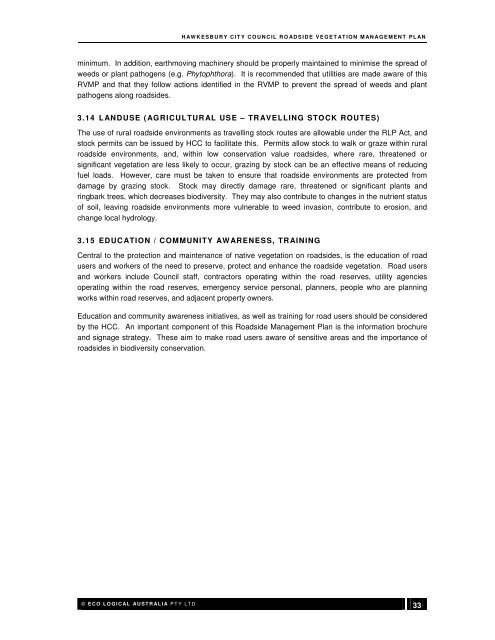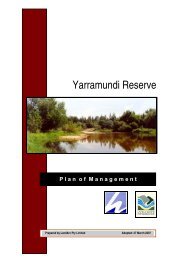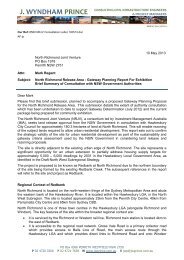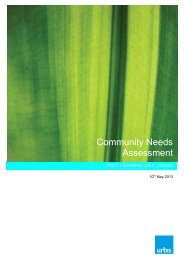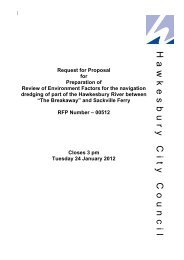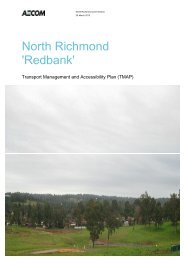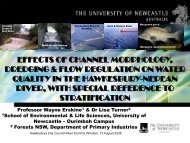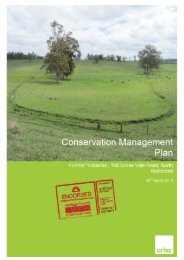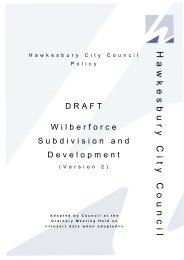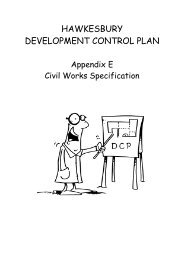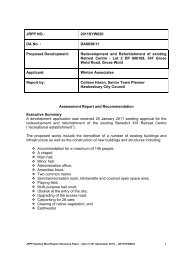Attachment 1 to Item 53 - Roadside Vegetation Management Plan
Attachment 1 to Item 53 - Roadside Vegetation Management Plan
Attachment 1 to Item 53 - Roadside Vegetation Management Plan
Create successful ePaper yourself
Turn your PDF publications into a flip-book with our unique Google optimized e-Paper software.
H AW K E S B U R Y C IT Y C O U N C IL R O AD S ID E V E G E T AT IO N M AN AG E M E N T P L AN<br />
minimum. In addition, earthmoving machinery should be properly maintained <strong>to</strong> minimise the spread of<br />
weeds or plant pathogens (e.g. Phy<strong>to</strong>phthora). It is recommended that utilities are made aware of this<br />
RVMP and that they follow actions identified in the RVMP <strong>to</strong> prevent the spread of weeds and plant<br />
pathogens along roadsides.<br />
3.14 LANDUSE (AGRICULTURAL USE – TRAVELLING STOCK ROUTES)<br />
The use of rural roadside environments as travelling s<strong>to</strong>ck routes are allowable under the RLP Act, and<br />
s<strong>to</strong>ck permits can be issued by HCC <strong>to</strong> facilitate this. Permits allow s<strong>to</strong>ck <strong>to</strong> walk or graze within rural<br />
roadside environments, and, within low conservation value roadsides, where rare, threatened or<br />
significant vegetation are less likely <strong>to</strong> occur, grazing by s<strong>to</strong>ck can be an effective means of reducing<br />
fuel loads. However, care must be taken <strong>to</strong> ensure that roadside environments are protected from<br />
damage by grazing s<strong>to</strong>ck. S<strong>to</strong>ck may directly damage rare, threatened or significant plants and<br />
ringbark trees, which decreases biodiversity. They may also contribute <strong>to</strong> changes in the nutrient status<br />
of soil, leaving roadside environments more vulnerable <strong>to</strong> weed invasion, contribute <strong>to</strong> erosion, and<br />
change local hydrology.<br />
3.15 EDUCATION / COMMUNITY AWARENESS, TRAINING<br />
Central <strong>to</strong> the protection and maintenance of native vegetation on roadsides, is the education of road<br />
users and workers of the need <strong>to</strong> preserve, protect and enhance the roadside vegetation. Road users<br />
and workers include Council staff, contrac<strong>to</strong>rs operating within the road reserves, utility agencies<br />
operating within the road reserves, emergency service personal, planners, people who are planning<br />
works within road reserves, and adjacent property owners.<br />
Education and community awareness initiatives, as well as training for road users should be considered<br />
by the HCC. An important component of this <strong>Roadside</strong> <strong>Management</strong> <strong>Plan</strong> is the information brochure<br />
and signage strategy. These aim <strong>to</strong> make road users aware of sensitive areas and the importance of<br />
roadsides in biodiversity conservation.<br />
© E C O L O G I C AL AU S T R AL I A P T Y L T D<br />
33


